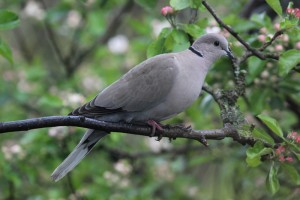 Some birds are adapting to the many changes in garden feeders for wild birds and a good example are the spillage trays. Many people are now using these to save any spilled grain from falling to the ground and making a mess, let alone spreading disease. These are plastic trays screwed to the bottom of the feeders and most garden centres are now stocking these, although they are an extra accessory to purchase. Many smaller birds actually use these trays to feed finding them much easier than clinging to the side or perching on the short narrow perches on the feeder itself. However, some of the larger birds are now using these trays and one of the first to adapt to this new approach was the woodpigeon. These large, rather rotund, birds have two disadvantages and one is that their mere presence is enough to keep the smaller birds away. The other problem is that they also get through the feed very quickly. Extra cost to an ever increasing bill for feeding wild birds in the garden.
Some birds are adapting to the many changes in garden feeders for wild birds and a good example are the spillage trays. Many people are now using these to save any spilled grain from falling to the ground and making a mess, let alone spreading disease. These are plastic trays screwed to the bottom of the feeders and most garden centres are now stocking these, although they are an extra accessory to purchase. Many smaller birds actually use these trays to feed finding them much easier than clinging to the side or perching on the short narrow perches on the feeder itself. However, some of the larger birds are now using these trays and one of the first to adapt to this new approach was the woodpigeon. These large, rather rotund, birds have two disadvantages and one is that their mere presence is enough to keep the smaller birds away. The other problem is that they also get through the feed very quickly. Extra cost to an ever increasing bill for feeding wild birds in the garden.
Another comparatively large bird, but smaller and much slimmer than the woodpigeon, is the collared dove that now spends all the year round in many gardens and often breeds there. They are one of the few birds where occupied nests have been found in every month of the year. They, like the woodpigeon, have now adapted to the spillage trays but they have learn to utilise a wider variety of feed including those with mixed grain, sunflower hearts and even peanuts. They will even try and get nyjer seed from the specialised feeders. The one in the photograph is in an Inverness garden and is just about to fly onto a spillage tray and feed on sunflower hearts. The collared doves, like the woodpigeon’s, will frighten away smaller birds but not to the same degree.
Adaptability is sometimes subtle and difficult to understand and such was the case with the tiny coal tits. These birds have often fascinated people who feed garden birds because the coal tits are so quick at the feeders. They are in and out without pausing to eat the food they have gone for. The reason is that they constantly store food and the birds you see doing a quick turnaround are just taking seed away and caching it somewhere such as in a slight hollow in a tree. Once you realise what is going on it is easy understand but in my garden last week the coal tits were the reason behind a mystery. A new feeder was being used where there is a clear Perspex front that has a fairly narrow slit at the bottom. The idea is that birds will peck at the available seed and then gravity feeds down the rest of the seed. However, with the one I was using the mixed seed was just going too fast and piling up on the ground below as there is no tray for this design, as yet. It took me a while to realise that coal tits were coming in and deliberately selecting the black sunflower seeds and flying off quickly. They ignored the rest of the mixed grain but threw it to one side as they searched for the seed they wanted. That is why the seed was scattered on the ground below. Other birds have also adapted to different feeders at this time of the year and they include the flamboyant great-spotted woodpecker, the blackbird and the feral doves. Garden birds have never been so fascinating as at this time of the year when many have young to look after and feed.
Tags: highland wildlife
